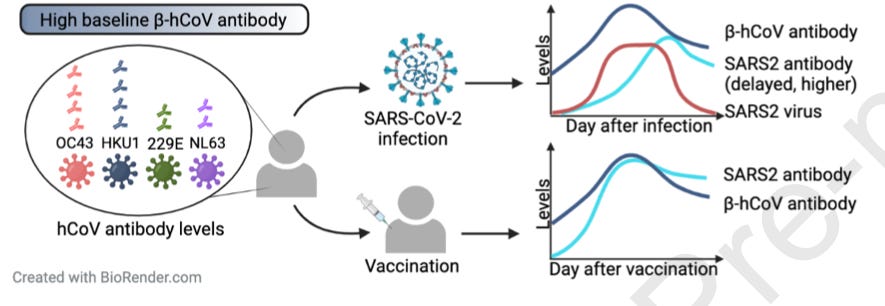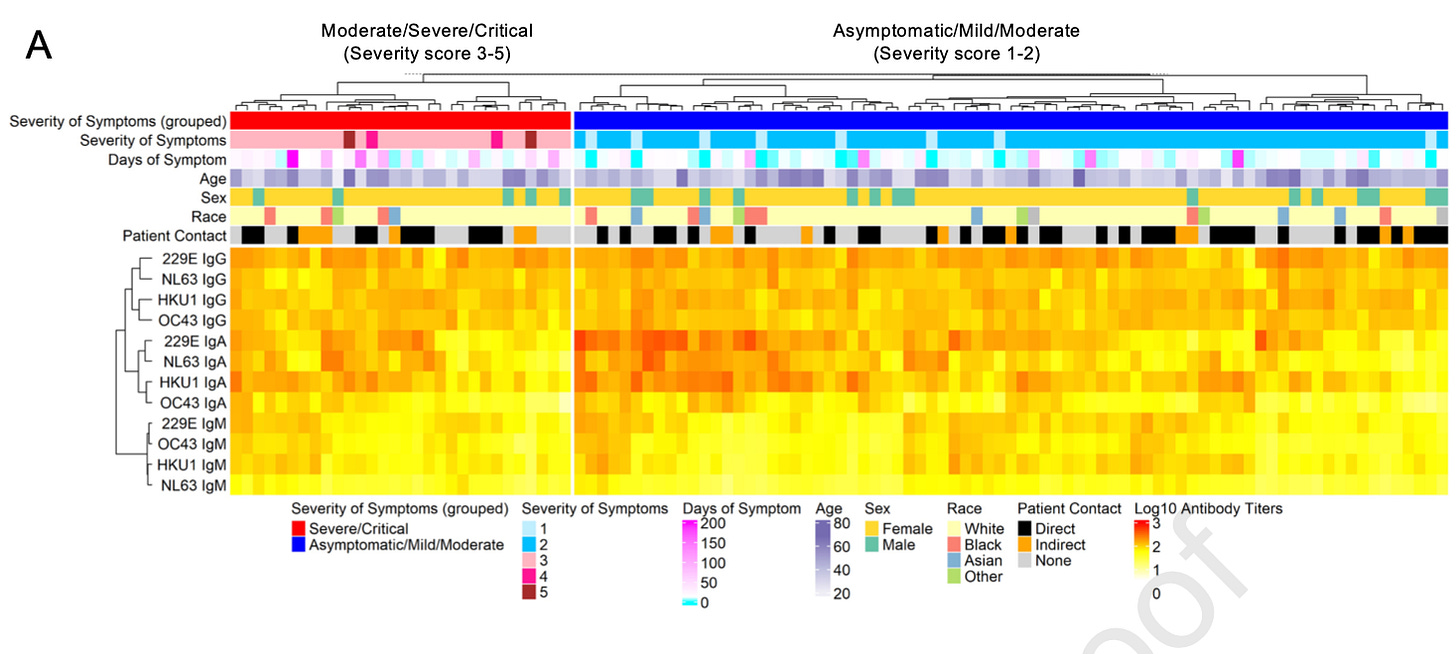Darmok and the Spike Protein at Tanagra
Copyright ©1991 FrancisCo
→New Game
Options
Often, in biology, theses are hard to test against. Original Antigenic Sin is not such a thesis; that’s how we’re so sure it’s real.
The proposition is simple. Prior exposure to a viral antigen results in antibodies that hinder immune response to a new version of the same virus.
Actually, that’s not simple at all. “Immune response” is a rather all-encompassing term.
So, let the record state that the thesis already has blanket wiggle-room to escape all possible falsification by ad hoc redefinition of “immune response.”1 So, it’s actually pretty hard to test against Original Antigenic Sin, because “immune response” can mean a pretty infinite range of things. That’s how we’re so sure it’s real.2
Original Antigenic Sin is so real, in fact, that it is non-falsifiable. You probably wouldn’t get why this makes Original Antigenic Sin anything other than a myth. It requires a pretty deep understanding of immunology.3
Get exposed to the flu, have the chills for a day, but don’t develop new antibodies? Congrats, you have a hindered “immune response.” Mm, hm, looks like your dumb and stupid immune system doesn’t know how to make antibodies anymore. And, hello, you kind of need those? Otherwise you can’t have Immunity™. That’s Original Antigenic Sin.
Get exposed to SARS-CoV-2, and develop a high amount of antibodies to the Receptor Binding Domain of the spike protein? Holy cow; you’ve really blown it now!4
Little did you know, that high antibodies to the Receptor Binding Domain of the spike protein are correlated with more severe outcomes! Even though plenty of mild cases of infection also result in high antibodies to the Receptor Binding Domain of the spike protein, you would obviously only have high antibodies to the Receptor Binding Domain of the spike protein if you weren’t making enough antibodies to the Receptor Binding Domain of the spike protein. Yeah, you read that right, idiot. Positive is Negative.
And why did your high antibodies resulting from low antibodies happen? Because you had too many antibodies to another coronavirus. See, our chart says so. Don’t ask for our measurements of your actual generation of antibodies to the Receptor Binding Domain of the spike protein over time. You wouldn’t be able to understand them. Bottom line is we definitely know you were not able to make enough antibodies to the Receptor Binding Domain of the spike protein (negative response) because you tried to make antibodies to other coronaviruses which is why you made so many antibodies to the Receptor Binding Domain of the spike protein (Negative Response). The fact that you had to do it more (because we know you had a severe outcome based on the fact that you did it more) is Clear Proof that you were unable to do it. That’s Original Antigenic Sin.
Looks like your dumb immune system blew it again. As far as immunology is concerned, you’re actually literally dead now.
YOU ARE DEAD.
Score: 2466 - Plebe.
→Restart…
Darmok and the Spike Protein at Tanagra
Copyright ©1991 FrancisCo
New Game
→Options
Evasive Language: →On / Off
Evasive Language: On / →Off
Evasive Language: On / →Off
→New Game
Often, in biology, theses are hard to test against. Original Antigenic Sin is not such a thesis. The proposition is simple. Prior exposure to a viral antigen results in antibodies that hinder immune response to a new version of the same virus, by taking up some hypothetically zero-sum memory immunity bandwidth,5 concretely resulting in negative outcomes to infection in real life.
Why else would anyone insist it is something to worry about, after all, if it had no relationship to negative outcomes - if it merely referred to functional cross-immunity in absence of observable antibody formation? That would be pretty weird!
Implicitly, Original Antigenic Sin proposes a negative outcome resulting from prior exposure to an antigen. Scratch that - from initial exposure to an antigen. It wouldn’t be very “original” if it referred to anything else, would it? That would be pretty weird, too!
Get exposed to the flu, have the chills for a day, but don’t develop new antibodies? Congrats, you have cross-immunity from other influenza viruses, or maybe just really excellent innate immunity.
Get exposed to SARS-CoV-2, and develop a high amount of antibodies to the Receptor Binding Domain of the spike protein? Well, that doesn’t really mean anything. Lots of mild infections result in high amounts of antibodies to the Receptor Binding Domain of the spike protein. There are more mild infections than severe infections, so it’s pretty irrelevant. We should look at your actual infection outcomes.
Oh, you were in a study comparing outcomes? Wow, that’s tremendous!
And before your infection, the study measured levels of antibodies to pre-existing coronaviruses - in you, and several other infected participants? This gives us a chance to try to falsify Original Antigenic Sin! That’s super, because it’s an easily falsifiable thesis and that’s why we know it’s real.
Of course, we don’t really have to look at the results, since we’re sure the results will show that folks with moderate-severe outcomes had more pre-existing antibodies to coronavirus, but just for kicks, let’s give it a go:
Oh. That’s strange. Participants with high pre-existing antibodies against other coronaviruses had mild outcomes… just as often as those with low antibodies. And vice-versa. These results demonstrate that Original Antigenic Sin is actually… not real.
It has been falsified.
Er - we’re sure your study authors will promptly report this to the scientific community at large, ushering a new age of progress!6 Congratulations on helping to advance the human race as a whole!
YOU ARE DEAD.
Score: [Error]7
→Restart…8
Much like “Herd Immunity.”
Much like “Herd Immunity.”
Much like “Herd Immunity.”
From Lin, C. et al. “Pre-existing humoral immunity to human common cold coronaviruses negatively impacts the protective SARS-CoV-2 antibody response.” Cell Host and Microbe.
As opposed to the obvious negative hypothesis that ramping up of previously-designed antibodies has literally no impact on the speed of novel antibody generation. It is already abundantly understood that adults and the elderly are already slower at the latter in general; pre-existing antibodies do not, for example “cause” the slower proliferation and retirement of T Cells that already slows down the generation of new epitopes in adults compared to children. Since the default generation of novel T Cell epitopes is slow to begin with, it is all the harder to quantify the effect of any theoretical proportional “hinderance” of downstream novel antibody secretion via short-term resource competition.
In fact, the authors do report this result (emphasis added):
We found no significant difference between baseline hCCCoV antibody levels and disease severity when comparing these two groups (Figure 5A and 5B). Moreover, symptom duration did not correlate with baseline hCCCoV antibody levels (Figure 5A and S5).
Linking baseline coronavirus antibody levels to end-point levels of antibody against the SARS-CoV-2 spike protein is a naked Hail Mary attempt to rescue their implicit hypothesis in the wake of its falsification, by, what else, redefining “immune response” to only refer to antibody generation.
High generation of anti-RBD IgG antibody is not, in fact, a “correlate” for severe outcomes to infection either in general or in this study. Although severe infections (not resulting in death) typically result in high antibody levels, so do lots of mild infections. In fact, any random crop of mild infections will turn up plenty of high-anti-RBD antibody generators.
See, for example, Seow, J. et al. “Longitudinal observation and decline of neutralizing antibody responses in the three months following SARS-CoV-2 infection in humans.” Nature. Black lines represent antibody responses in mild infections; red corresponds to severe:
Grouping “high” antibody generators together will, of course, result in the mathematical fabrication of a higher prevalence of severe outcomes relative to “low” antibody generators - but that is only because low antibody generators are a good correlate for mild outcomes, not the other way around. Throwing a rock at high antibody generators will hit a mild outcome on the head as often as not (particularly in a real-life setting, where mild cases vastly outnumber moderate/severe).
Additionally, one could presumably define “high” at whatever ELISA benchmark one wanted to, until the desired input value - in this case, baseline antibodies against coronavirus among participants - were skewed in the desired direction. Here, the authors do not show their math. And it wouldn’t matter if there were math.
High baseline antibodies cannot correlate to severe outcomes, if they didn’t result in severe outcomes in real life.
We found no significant difference between baseline hCCCoV antibody levels and disease severity when comparing these two groups (Figure 5A and 5B). Moreover, symptom duration did not correlate with baseline hCCCoV antibody levels (Figure 5A and S5).
These are hacked results, in the service of puffing up a scientific myth, instead of advancing human understanding of natural immunity.
Even more galling, the authors use high generation as a proxy for low (initial) generation; but they do not present the actual antibody kinetics (responses over time) for anti-RBD antibody. These values should have been available to the authors, as they are plotted for anti-coronavirus antibodies (though, individual participants may not be represented in multiple time-points).
Yet, to salvage Original Antigenic Sin, such an outcome must be assumed out of whole cloth, though it is so absurd that it cannot be uttered aloud, only implied in the appended Graphical Abstract.
Again, the actual SARS2 antibody values are not presented; were they in fact “delayed, higher,” or is this just a conjecture? Note that in the responses plotted by Seow, J. et al., severe infections are characterized by more rapid antibody level elevation than mild, implying no positive relationship between “slowness” of antibody generation and severe infection outcomes.
“Darmok” is a famous Star Trek: The Next Generation episode, which features an alien culture that only speaks in familiar memes that refer to ancient myths - though the understanding of “memes” as signifiers for qualitative and contextual characterizations of real-life human interactions would not arrive until two decades after the show aired. It is thus doubly famous for unintentionally predicting human future in the form of fictional alien primitivism. As Original Antigenic Sin is an immunological myth, an obstacle to meaningful communication, and a meme all in one, the send-up to “Darmok” seemed obvious.
For previous comments on the myth of Original Antigenic Sin, see “(Not) Coming Up.”
And briefly, regarding another recent study: Goldberg, Y. et al. “Protection and waning of natural and hybrid COVID-19 immunity.”
This may be an artifact of different background case rates, depending on where person-days actually fell in the calendar - however, the study period was during consistent high spread (August 1 - September 30), so this hazard is probably nonexistent. Thus, the results are quite encouraging.
Although the vaccinated + recovered do not fare quite as well as the truly naturally immune, it seems that there has been significant correction to the outright deficiency of the vaccine immune response, post “breakthrough” infection.
But if “Not 100% perfect response to later viral challenge” is the definition of Original Antigenic Sin in the context of Covid-vaccination, the goal-post for OAS Is Real might as well be placed inside the locker room.
















A famous quote comes to mind, "Show me your graph, and I'll show you another graph."
Damn. I can't recall a more elegant discussion of immunology.
We should all keep in mind that 100% perfect response is not only unlikely, but unnecessary. Good enough is good enough.